|
|
|
| Introduction | |
| Habitats | |
| References | |
| Back to Table of Contents | |
|
|
|

Chapter 11
By
Peter J. Auster1 and
Robert E. DeGoursey2
|
|
|
| Introduction | |
| Habitats | |
| References | |
| Back to Table of Contents | |
|
|
|
The images provided in this gallery serve as examples of the types of
interactions with habitat features that organisms exhibit in the Southern
New England region of the Northwest Atlantic. Images were collected
during various projects from 1974 through 1998. Habitats have been
divided into gravel (including boulder), sand, mud, seagrass, and pelagic
categories. Of particular interest is that many species off southern New
England do not have obligate habitat requirements or shift preferred habitats
as they grow in size and age. Unlike most coral reef fishes that
require reef habitats for shelter and prey, many but not all temperate
fishes have only facultative habitat requirements. These species
may have greater survival in particular habitats but some can survive in
one or more other habitats. These life history characteristics can
mask the effects of natural or human caused disturbances to particular
habitats on populations of various species but such disturbances can have
significant consequences to long-term population dynamics.
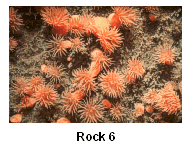 complexity,
the wider the range of sizes of organisms that utilize such habitats.
For example, cunner, a temperate wrasse, are often the dominant fish species
in boulder habitats. In fact, cunner occur in the same densities
as coral reef fiishes in terms of numbers and biomass as coral reef fishes.
For gravel pavements (i.e., flat gravel areas), the lower three dimensional
structure of the seafloor restricts the sizes of animals which can find
refuge from tidal flows and predators. Juvenile fishes and small
crustaceans find shelter amongst the epifaunal species which colonize the
gravel surfaces, the sides of cobbles, and also burrow directly beneath
various size rocks.
complexity,
the wider the range of sizes of organisms that utilize such habitats.
For example, cunner, a temperate wrasse, are often the dominant fish species
in boulder habitats. In fact, cunner occur in the same densities
as coral reef fiishes in terms of numbers and biomass as coral reef fishes.
For gravel pavements (i.e., flat gravel areas), the lower three dimensional
structure of the seafloor restricts the sizes of animals which can find
refuge from tidal flows and predators. Juvenile fishes and small
crustaceans find shelter amongst the epifaunal species which colonize the
gravel surfaces, the sides of cobbles, and also burrow directly beneath
various size rocks.
Rock 1 - Kelp forest (Laminaria) and boulders provide complex rock reef habitats along the southern New England coast. Cunner (Tautogolabrus adspersus) are the most common reef fish in this region.
Rock 2 - Cunner (Tautogolarus adspersus) foraging on sea strawberries (Tubularia sp.), a species of hydroid. Note the additional complex habitat formed by the dense stalks of the Tubularia.
Rock 3 - Squid lay eggs on rock surfaces. Here cunner (Tautogolarus adspersus) are preying on these egg masses.
Rock 4 - Tautog (Tautoga onitis) use deep crevices in boulder reefs for shelter.
Rock 5 - American eel (Anguilla rostrata) swimming through complex boulder and macroalgae habitat.
Rock 6 - Anenomes attached to boulder surfaces produce additional habitat complexity for small organisms.
Rock 7 - The frilled anenome (Metridium senile) can occur in dense aggregations.
Rock 8 - Deadman's finger sponge
(Haliclona oculata) attached to cobble bottom provides significant three
dimensional structure.
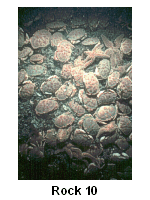
Rock 9 - Sea strawberries occur seasonally after they settle onto hard rock surfaces from the plankton. Nudibranchs (Coryphella rufibranchialis) prey on these hydroids when available.
Rock 10 - A dense aggregation of rock crabs (Cancer irroratus) preying on newly settled mussels (Mytilus edulis) on a boulder reef.
Rock 11 - A juvenile lobster
(Homarus americanus) at the entrance of a burrow. Cobbles serve as
the roof stones of burrows and the chamber is excavated from a mixuture
of cobbles, pebbles and fine cohesive sediments.
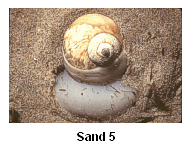 not
adhere to one another. This prevents construction of defined burrows
by animals. However, many species are adapted to life in these habitats.
For example, many crab species can rapidly bury themselves in unconsolidated
sand in order to avoid threats. Tidal and storm currents act on sands
to form sand waves and ripples. These features, like other habitats,
provide refuges from current flows, reducing the energy needed by fishes
to hold position on the sea floor. Some fish species wait on the
down-current sides of sand waves to ambush prey drifting over the bottom.
not
adhere to one another. This prevents construction of defined burrows
by animals. However, many species are adapted to life in these habitats.
For example, many crab species can rapidly bury themselves in unconsolidated
sand in order to avoid threats. Tidal and storm currents act on sands
to form sand waves and ripples. These features, like other habitats,
provide refuges from current flows, reducing the energy needed by fishes
to hold position on the sea floor. Some fish species wait on the
down-current sides of sand waves to ambush prey drifting over the bottom.
Sand 1 - Lobsters (Homarus americanus) form dish depressions for limited cover when in sand habitats.
Sand 2 - Sand habitats provide limited cover for fishes. A grubby sculpin (Myoxocephalus aenaeus) was attacked by bluefish, which approach from the rear. Here a green crab (Carcinus maenus) feeds on the remaining head.
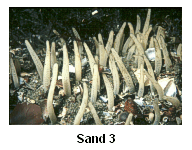 Sand
3 - Sponges are rare in sand habitats. A Polymastia robusta,
attached to buried cobbles, extends through the sand surface.
Sand
3 - Sponges are rare in sand habitats. A Polymastia robusta,
attached to buried cobbles, extends through the sand surface.
Sand 4 - High densities of lobster traps also provides cover for juvenile lobsters.
Sand 5 - Predation also takes place beneath the surface in sedimentary environments. A predatory moon snail, Lunatia heros, plows beneath the sediment surface in search of prey.
Sand 6 - A rock gunnel (Pholis gunnelus) uses quahog shells for cover.
Sand 7 - Winter flounder (Pleuronectes americana) are adapted to capture prey in the sediment surface. A small fleshy mouth enhances capture of small clams and worms.
Sand 8 - Northern sea robin (Prionotus
carolinus) use modified pectoral fins to search for prey in soft sediments.
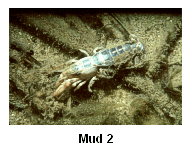 highly
modify mud habitats exploiting the cohesive nature of the fine sediments
and organic materials. Burrows of various sizes and configurations,
as well as shallow depressions, greatly increase the complexity of such
habitats. Lobsters are perhaps the most well studied of the many
burrowing species. Some animals are structure producers and others
use structures produced by other fauna. For example, species like
lobsters and four bearded rockling produce bowl shaped depressions on the
sediment surface. Other species like longfinned squid use abandoned
depressions for cover.
highly
modify mud habitats exploiting the cohesive nature of the fine sediments
and organic materials. Burrows of various sizes and configurations,
as well as shallow depressions, greatly increase the complexity of such
habitats. Lobsters are perhaps the most well studied of the many
burrowing species. Some animals are structure producers and others
use structures produced by other fauna. For example, species like
lobsters and four bearded rockling produce bowl shaped depressions on the
sediment surface. Other species like longfinned squid use abandoned
depressions for cover.
Mud 1 - A polychaete worm (Nereis virens), which normally lives in tubes within the seafloor, crawls on the sediment surface during spawning.
Mud 2 - Mud shrimp (Axius serratus) burrows up to 1 m deep into cohesive mud substrates.
Mud 3 - A grass shrimp (Crangon septemspinosa) partially burrowed into the mud surface. Note the consistency of the cohesive mud substrate. The narrow paths on either side of the shrimp are made by snails.
Mud 4 - A Jonah crab (Cancer borealis) excavates a pit in the mud seafloor to expose potential prey such as bivalve molluscs.
Mud 5 - A juvenile lobster (Homarus americanus) in a mud burrow. The entrance is a vertical opening beneath the sediment surface with a chamber excavated horizontally. Many mud burrows also have an escape opening.
Mud 6 - A lobster "boxing" a Jonah crab out of a burrow using it's two major claws.
Mud 7 - Rock crabs (Cancer irroratus) burrow into mud substrates for shelter after they molt. Note the shed shell adjacent to the burrowed crab.
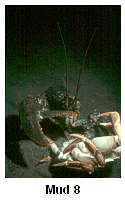 Mud
8 - A lobster preying on a newly molted rock crab. The lack
of mud on the crab suggests that the lobster was able to capture this individual
before it was able to burrow.
Mud
8 - A lobster preying on a newly molted rock crab. The lack
of mud on the crab suggests that the lobster was able to capture this individual
before it was able to burrow.
Mud 9 - Spider crabs (Libinia emarginata) return to the same general area of mud bottom each year to mate. Other areas are used to burrow into mud and sand for overwintering.
Mud 10 - A green crab (Carcinus maenus) preys on an American eel (Anguilla rostrata) which was captured when the eel burrowed into the mud to overwinter.
Mud 11- Four bearded rockling (Enchelyopus cimbrius) produce depressions in the sediment surface. This behavior provides shelter and exposes potential prey.
Mud 12 - A close-up of the seafloor covered with amphipod tubes (Ampelesca spp.) . The tubes are a mixture of mud grains and mucus and provide shelter for the amphipod inside. The tubes provide cover for other small organisms such as juvenile fishes and crustaceans.
Mud 13 - A red hake (Urophycis
chuss) in a burrow excavated from a steep slope which exposes laminated
clay outcrops.
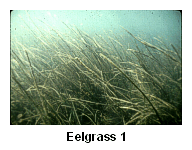 Seagrass
(e.g. eelgrass) and macroalgae habitats are shallow and complex environments.
Seagrasses and seaweeds are often the dominant structure forming organisms
in shallow waters. Like habitats on land, the species are primary
producers (like meadows of grasses or forests of trees). Dense seagrass
meadows or tall forests of kelp also provide refuge from predators and
tidal currents. However, there presence is generally seasonal.
Winter die-off removes the predominant structure in these habitats.
Seagrass
(e.g. eelgrass) and macroalgae habitats are shallow and complex environments.
Seagrasses and seaweeds are often the dominant structure forming organisms
in shallow waters. Like habitats on land, the species are primary
producers (like meadows of grasses or forests of trees). Dense seagrass
meadows or tall forests of kelp also provide refuge from predators and
tidal currents. However, there presence is generally seasonal.
Winter die-off removes the predominant structure in these habitats.
Eelgrass 1 - Wide angle view of an eelgrass (Zostera marina) meadow.
Eelgrass 2 - Bay scallops (Argopecten irradians) are common inhabitants of eelgrass meadows.
Eelgrass 3 - Bay scallops have blue eyes that can see light and dark.
Eelgrass 4 - Bay scallops attach to eelgrass blades when they settle from the plankton. Note the byssus threads behind the hinge used to attach to the blade.
Eelgrass 5 - Juvenile bay scallops and other attached fauna have a refuge from predation on the upper ends of eelgrass blades. Predators such as this hermit crab (Pagurus longicarpus) can climb part way up blades and prey on attached organisms.
Eelgrass 6 - Small starfish (Asterias forbesi) can climb eelgrass blades to prey on attached organisms.
Eelgrass 7 - Juvenile scup (Stenotomus chrysops) use eelgrass meadows as nursery grounds.
Eelgrass 8 - Pipefish (Sygnathus fuscus) swim slowly amongst eelgrass blades to ambush zooplankton, shrimps and small fish.
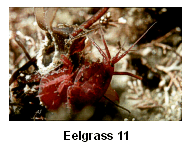 Eelgrass
9 - A naked goby (Gobiosoma bosc) uses macroalgae in an eelgrass
meadow for cover.
Eelgrass
9 - A naked goby (Gobiosoma bosc) uses macroalgae in an eelgrass
meadow for cover.
Eelgrass 10 - A rock gunnel (Pholis gunnelus) using a scallop shell for shelter.
Eelgrass 11 - An amphipod scavenging
on drift macroalgae in an eelgrass bed.
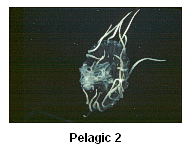 The
water column also provides a "habitat" structure for a number of species.
For example, frontal boundaries and convergence zones tend to concentrate
plankton and enhance foraging for small fishes and crustaceans. Gelatinous
zooplankton also provide structure in the water column. Organisms
resistant to stinging cells have been observed using the tentacles and
bells of jellyfish for shelter. While these habitats are ephemeral
in nature, they can increase the fitness of individual organisms.
The
water column also provides a "habitat" structure for a number of species.
For example, frontal boundaries and convergence zones tend to concentrate
plankton and enhance foraging for small fishes and crustaceans. Gelatinous
zooplankton also provide structure in the water column. Organisms
resistant to stinging cells have been observed using the tentacles and
bells of jellyfish for shelter. While these habitats are ephemeral
in nature, they can increase the fitness of individual organisms.
Pelagic 1 - Moon jellies (Aurelia aurita) occur in large concentrations along convergence zones.
Pelagic 2 - Sea nettles (Chrysaora quinquecirrha) can occur in large concentrations in estuaries.
Pelagic 3 - A lions mane jellyfish capturing a sea gooseberry (Pleurobrachia pileus). Sea gooseberries reach high densities along convergence zones. Lion's mane jellyfish (Cyanea capillata) then swim up, then drift down through, such aggregations to capture prey.
Pelagic 4 - Close-up in the tentacles of a lion's mane jellyfish (Cyanea capillata) capturing many sea gooseberries.
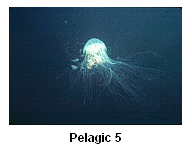 Pelagic
5 - Juvenile butterfish (Peprilus tricanthus) using the tentacles
of lion's mane jellyfish (Cyanea capillata) for shelter.
Pelagic
5 - Juvenile butterfish (Peprilus tricanthus) using the tentacles
of lion's mane jellyfish (Cyanea capillata) for shelter.
Pelagic 6 - Not all benthic animals stay benthic. At night, this grass shrimp (Crangon septemspinosa) was observed searching the water column several meters above the sea floor for prey. The sea floor provides cover during the day from visual predators.
Pelagic 7 - This juvenile goosefish (Lophius americanus) is pelagic but will soon migrate to the seafloor where it will assume the role of an ambush predator of demersal organisms.
Pelagic 8 - Blue crabs (Callinectes sapidus) occasionally uses swimmerets to swim and search for prey at night. They also use their swimmerets to escape predators. They take refuge during the day on the seafloor.
Pelagic 9 - A parasitic amphipod (Phronima sedentaria) living within a dead segment of a salp.
Pelagic 10 - Sea butterflies
occur in the sounds region when offshore and slope water, as well as warm
core rings, move inshore along Southern New England.
Auster, P.J., Malatesta, R.J., LaRosa, S.C., Cooper, R.A., and Stewart, L.L., 1991, Microhabitat utilization by the megafaunal assemblage at a low relief outer continental shelf site - Middle Atlantic Bight, USA: Journal of Northwest Atlantic Fisheries Science, v. 11, p. 59-69.
Auster, P.J., Malatesta, R.J., and LaRosa, S.C., 1995, Patterns of microhabitat utilization by mobile megafauna on the southern New England (USA) continental shelf and slope: Marine Ecology Progress Series, v. 127, p. 77-85.
Auster, P.J., Malatesta, R.J., Langton, R.W., Watling, L., Valentine, P.C., Donaldson, C.L.S., Langton, E.W., Shepard, A.N., and Babb, I.G., 1996, The impacts of mobile fishing gear on seafloor habitats in the Gulf of Maine (northwest Atlantic): Implications for conservation of fish populations: Reviews in Fisheries Science, v. 4, p. 185-202.
Auster, P.J., and Langton R.W., 1999, The effects of fishing on fish habitat, In: L. Benaka (ed.). Fish Habitat: Essential Fish Habitat and Rehabilitation: American Fisheries Society, Bethesda, Maryland, p. 150-187.
Langton, R.W., Auster, P.J., and Schneider, D.C., 1995, A spatial
and temporal perspective on research and management of groundfish in the
northwest Atlantic: Reviews in Fisheries Science, v. 3, p.
201-229.